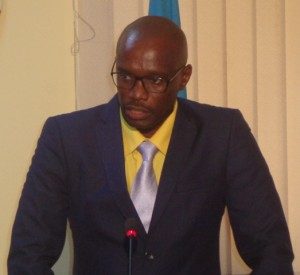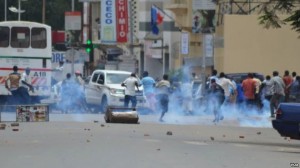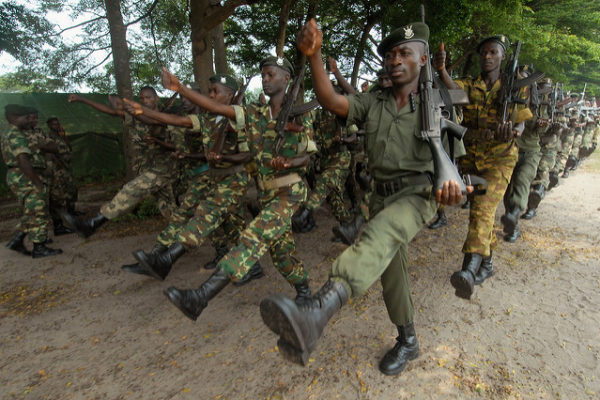 The crisis in Burundi, ongoing since the April 25 announcement by President Pierre Nkurunziza to seek a third term in office, is entering into a dangerous phase. In a speech on November 3, Burundian Senate President Reverien Ndikuriyo incited ethnically-based violence: “You tell those who want to execute the mission: on this issue, you have to pulverize, you have to exterminate—these people are only good for dying. I give you this order, go!” Such language harkens back to Burundi’s divisive 1993–2005 civil war in which 300,000 were killed. Independent media reports have subsequently reported large population movements in areas of southern Burundi home to the ethnic minority Tutsi population. Underscoring the growing concern of the onset of genocidal violence, on November 6 the Prosecutor of the International Criminal Court issued a statement:
The crisis in Burundi, ongoing since the April 25 announcement by President Pierre Nkurunziza to seek a third term in office, is entering into a dangerous phase. In a speech on November 3, Burundian Senate President Reverien Ndikuriyo incited ethnically-based violence: “You tell those who want to execute the mission: on this issue, you have to pulverize, you have to exterminate—these people are only good for dying. I give you this order, go!” Such language harkens back to Burundi’s divisive 1993–2005 civil war in which 300,000 were killed. Independent media reports have subsequently reported large population movements in areas of southern Burundi home to the ethnic minority Tutsi population. Underscoring the growing concern of the onset of genocidal violence, on November 6 the Prosecutor of the International Criminal Court issued a statement:
“… that any person in Burundi who incites or engages in acts of mass violence including by ordering, requesting, encouraging or contributing in any other manner to the commission of crimes falling within the jurisdiction of the International Criminal Court [of which Burundi is a signatory] is liable to prosecution before this Court.”
The African Union warned that if the crisis is not urgently resolved it would have devastating consequences for Burundi and the entire region. UN Special Rapporteur on transitional justice Pablo De Grieff said that inaction on Burundi demonstrates that the “international architecture is showing its cracks” in dealing with a crisis that has already resulted in more than 200,000 registered refugees.
Political Origins
 At the heart of the crisis is the decision by Pierre Nkurunziza to attempt to stay in power for a third term. Many domestic and international observers view this as a violation of Burundi’s constitution and the terms of the Arusha Peace and Reconciliation Agreement of 2000 that laid out terms for ending cycles of violence, including genocide. This agreement, which many Burundians hail as their “Magna Carta,” gave the country “its only real chance for peace” according to one of its key architects, former South African President, Thabo Mbeki. Since the announcement to seek a third term, Burundi has seen more than two months of daily protests, intimidation of opposition parties and communities by government-sponsored militias, a failed coup attempt, the fleeing to exile of several senior government officials and military leaders, and the displacement of 10 percent of the country’s population. Violence between the regime and opposition forces has intensified in recent months with gunfire and grenade explosions occurring daily and targeted assassinations against both sides commonplace. Keeping track of these fluid developments is all the more difficult given that Burundi continues to suffer a media blackout following the closing of independent media outlets by government forces in May.
At the heart of the crisis is the decision by Pierre Nkurunziza to attempt to stay in power for a third term. Many domestic and international observers view this as a violation of Burundi’s constitution and the terms of the Arusha Peace and Reconciliation Agreement of 2000 that laid out terms for ending cycles of violence, including genocide. This agreement, which many Burundians hail as their “Magna Carta,” gave the country “its only real chance for peace” according to one of its key architects, former South African President, Thabo Mbeki. Since the announcement to seek a third term, Burundi has seen more than two months of daily protests, intimidation of opposition parties and communities by government-sponsored militias, a failed coup attempt, the fleeing to exile of several senior government officials and military leaders, and the displacement of 10 percent of the country’s population. Violence between the regime and opposition forces has intensified in recent months with gunfire and grenade explosions occurring daily and targeted assassinations against both sides commonplace. Keeping track of these fluid developments is all the more difficult given that Burundi continues to suffer a media blackout following the closing of independent media outlets by government forces in May.
Military professionalism
 Despite the extraordinary political pressures, the Burundian military has largely stayed neutral during much of the crisis. During the protests, soldiers have regularly acted as a buffer between protesters and police and government affiliated militias. The resistance to politicization has been widely attributed to Burundi’s 8-year Security Sector Development (SSD) Program. An embodiment of the Arusha Accords, the SSD has helped foster multiethnic cohesion and enabled Burundi to become an important contributor to African and international peacekeeping missions. The failed coup and ethnically-based purges of the security forces, however, have eroded this cohesion. Emile Ouédraogo notes that the breakdown in military professionalism often stems from political incentives when the military succumbs to manipulation by political elites pursuing unethical agendas. The Burundian military, therefore, is faced with negotiating the conflicting demands of its political leadership and maintaining its hard-earned institutional integrity.
Despite the extraordinary political pressures, the Burundian military has largely stayed neutral during much of the crisis. During the protests, soldiers have regularly acted as a buffer between protesters and police and government affiliated militias. The resistance to politicization has been widely attributed to Burundi’s 8-year Security Sector Development (SSD) Program. An embodiment of the Arusha Accords, the SSD has helped foster multiethnic cohesion and enabled Burundi to become an important contributor to African and international peacekeeping missions. The failed coup and ethnically-based purges of the security forces, however, have eroded this cohesion. Emile Ouédraogo notes that the breakdown in military professionalism often stems from political incentives when the military succumbs to manipulation by political elites pursuing unethical agendas. The Burundian military, therefore, is faced with negotiating the conflicting demands of its political leadership and maintaining its hard-earned institutional integrity.
Responsibility to Protect (R2P)
According to the United Nations, the duty to prevent and halt genocide and mass atrocities lies first and foremost with the state. Failing that, however, the international community has:
Responsibility to use appropriate diplomatic, humanitarian and other means to protect populations from these crimes. If a State is manifestly failing to protect its populations, the international community must be prepared to take collective action to protect populations, in accordance with the Charter of the United Nations.
Under such circumstances, sovereignty no longer protects states from foreign intervention. This principle is enshrined in article 1 of the Genocide Convention and embodied in the principle of “sovereignty as responsibility” and in the concept of the Responsibility to Protect. In response to the Burundi crisis, on October 17 the African Union Peace and Security Council authorized:
- An increase in the number of deployed African Union human rights and military monitors and police
- A report on human rights violations in Burundi to be submitted no later than December 1
- A compilation of a list of individuals and entities to be targeted by comprehensive sanctions
- Expedited contingency planning for the possible deployment of the East African Standby Force to prevent widespread violence
The deployment of such an intervention force would be focused on the protection of citizens. Paul Williams highlights several overarching lessons for citizen protection from peace operations over the past 15 years:
- An effective system of information gathering and analysis that detects patterns of atrocities and develops strategies and operational approaches to enable effective civilian protection
- A multi-layered concept of protection based on sound conflict analysis and operational guidelines
- Sufficient resources to undertake an effective civilian protection mission to include operational and tactical tasks.
Arusha as a Framework for Peace
Despite the continuing polarization of Burundi’s political environment, the framework for a solution is already in place. Crafted as a mechanism to break with Burundi’s tragic past, the Arusha Peace and Reconciliation Agreement is seen by a vast majority of Burundians from all backgrounds as the only viable option for inclusive peace. Similarly, despite the climate of growing mistrust, many Burundians have not allowed the old sectarian divides to take root. Crucially, Burundians agree that ethnicity, in itself, is not the source of their problems. Hutu, Tutsi, and their kinsmen the Twa, all share the same language and culture. Rather, it is the political manipulation of their differences in identity that has led to extreme inter-group conflicts and ultimately genocide. Fifteen years after the signing of the Arusha Accords Burundi is once again at a crossroads between peace and violence. The prospects for stability will depend greatly on how well Burundians continue to defend the multi-ethnic vision embodied in these Accords.
Africa Center Resources
- Paul D. Williams, “Enhancing Civilian Protection in Peace Operations: Insights from Africa,” ACSS Research Paper No 1, Africa Center for Strategic Studies, September 2010.
- Clement Mweyang Aapengnuo, “Misinterpreting Ethnic Conflicts in Africa,” Africa Security Brief No 4, Africa Center for Strategic Studies, April 2010.
- Emile Ouédraogo, “Advancing Military Professionalism in Africa” ACSS Research Paper No 6, Africa Center for Strategic Studies, July 2014.
Additional Resources
- Joseph Siegle, “Why Term Limits Matter for Africa” The International Relations and Security Network, July 3, 2015.
- “Burundi Conflict Alert” International Crisis Group, November 5, 2015.
- Thierry Vircoulon, “Insights from the Burundian Crisis: An Army Divided and Losing its Way,” October 2, 2015.
- Nicholas Kristof, “Mass Atrocities Looming in Burundi?” , International New York Times, November 6, 2015.
- Simon Allison, “Why the crisis in Burundi is Tying the African Union in Knots”, The Guardian, August 6, 2015.
More on: Peacekeeping Security Sector Governance African Union Burundi Ethnic Conflict Military Professionalism

